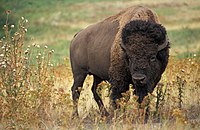
Photo from wikipedia
In 1919, the European bison population became extinct in the wild. The rescue of the lowland subspecies and the whole species was achieved mainly thanks to individuals from the Białowieża… Click to show full abstract
In 1919, the European bison population became extinct in the wild. The rescue of the lowland subspecies and the whole species was achieved mainly thanks to individuals from the Białowieża Forest (Polish-Belarusian border). There are currently two breeding lines—the lowland (purebred B. b. Bonasus) founded by 7 individuals and the lowland-Caucasian (hybrids of B. b. Bonasus and B. b. caucasicus) founded by 12 individuals. This genealogical study was conducted on 15,071 individuals recorded in the pedigree book between 1881 and 2020. Its objective was to determine the level of genetic variability and inbreeding almost 100 years after the rescue measures were initiated. The completeness of the pedigree of the reference population was 77% in the fifth generation backwards. A maximum of 23 generations can be traced back in the pedigree. The average inbreeding coefficient and the mean average relatedness of the reference population were very high, about 17% and 16% respectively. No significant amount of new inbreeding was discovered. The reference population has lost 9.11% of the total genetic diversity compared to the population of founders. A male of the Caucasian subspecies Kaukasus was discovered among the ancestors of the lowland lineage reference population. The effective population size calculated based on the increase in inbreeding was 23.93 individuals, based on complete generations equivalent it was 16.1 individuals. Wright’s F-statistics showed very small differences in genotypic frequencies between individuals within the two lineages in the reference population (FIS = 0.10), between individuals and the total population (FIT = 0.04) and low differentiation between lineages (FST = 0.06). The population of the European bison from the Białowieża Forest is generally very uniform but still shows good fitness.
Journal Title: PLOS ONE
Year Published: 2022
Link to full text (if available)
Share on Social Media: Sign Up to like & get
recommendations!